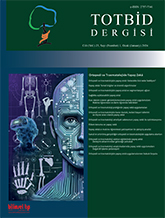
With the accumulation of clinical and radiographic data in electronic form, studies on the use of artificial intelligence in the medical field are increasing rapidly. The limits of conventional statistics can be easily overcome with the help of artificial intelligence and larger data sets can be analyzed faster. In orthopedics and traumatology, one of the medical fields where technological developments are most closely followed, there is an increasing interest in this subject. In addition to arthroplasty and spine surgery, where there are more studies on this field, there are also experimental applications of artificial intelligence in the field of joint preservation. Diagnostic applications, studies in which artificial intelligence is successful in surgical treatment planning and prognosis prediction in cartilage loss, meniscus and anterior cruciate ligament tears, as well as rotator cuff lesions and hip joint problems, continue to be served to the literature. However, there are several barriers to the incorporation of AI into the clinician`s standard practice in these areas. Ensuring the standardization and improving the quality of published studies on artificial intelligence, as well as taking advantage of other elements of advancing technology, will help artificial intelligence to gain a more important role in clinical practice in joint preservation in the future.